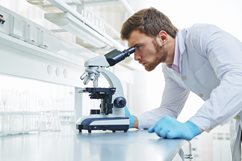IVF In-vitro Fertilisation
 What is IVF?
What is IVF?
In vitro fertilisation (IVF) literally means ‘fertilisation in glass’ giving us the familiar term ‘test tube baby’.
During the IVF process, eggs are removed from the ovaries and fertilised with sperm in the laboratory. The fertilised egg (embryo) is later placed in the woman’s womb.
Is IVF for me?
A clinic may recommend IVF as your best treatment option if:
- you have been diagnosed with unexplained infertility
- your fallopian tubes are blocked
- you have been unsuccessful with other techniques like using fertility drugs or intrauterine insemination (IUI)
- there is a minor degree of male subfertility - more severe problems are treated with intra-cytoplasmic sperm injection (ICSI).
How does IVF work?
IVF techniques can differ from clinic to clinic, often depending on your individual circumstances.
A typical treatment may involve:
For women:
Step 1. Suppressing the natural monthly hormone cycle
As a first step you may be given a drug to suppress your natural cycle.
Treatment is given either as a daily injection (which is normally self-administered unless you are not able to do this yourself) or a nasal spray. This continues for about two weeks.
Step 2. Boosting the egg supply
After the natural cycle is suppressed you are given a fertility hormone called FSH (or Follicle Stimulating Hormone). This is usually taken as a daily injection for around 12 days.
This hormone will increase the number of eggs you produce - meaning that more eggs can be fertilised. With more fertilised eggs, the clinic has a greater choice of embryos to use in your treatment.
Step 3. Checking on progress
Throughout the drug treatment, the clinic will monitor your progress. This is done by vaginal ultrasound scans and, possibly, blood tests.
34–38 hours before your eggs are due to be collected you have a hormone injection to help your eggs mature.
Step 4. Collecting the eggs
Eggs are usually collected by ultrasound guidance under sedation. This involves a needle being inserted into the scanning probe and into each ovary.
The eggs are, in turn, collected through the needle.
Cramping and a small amount of vaginal bleeding can occur after the procedure.
Step 5. Fertilising the eggs
Your eggs are mixed with your partner’s or the donor’s sperm and cultured in the laboratory for 16–20 hours. They are then checked to see if any have fertilised.
Those that have been fertilised (now called embryos) are grown in the laboratory incubator for another one - two days before being checked again. The best one or two embryos will then be chosen for transfer.
After egg collection, you are given medication to help prepare the lining of the womb for embryo transfer. This is given as pessaries, injection or gel.
Step 6. Embryo transfer
For women under the age of 40, one or two embryos can be transferred. If you are 40, or over, a maximum of three can be used.
The number of embryos is restricted because of the risks associated with multiple births. Remaining embryos may be frozen for future IVF attempts, if they are suitable.
Step 7. Other treatments
Some clinics may also offer blastocyst transfer, where the fertilised eggs are left to mature for five to six days and then transferred.
For information about embryo transfer, and the different methods used see:
For men:
Step 1. Collecting sperm
Around the time your partner’s eggs are collected, you are asked to produce a fresh sample of sperm.
This is stored for a short time before the sperm are washed and spun at a high speed. This is so the healthiest and most active sperm can be selected.
If you are using donated sperm, it is removed from frozen storage, thawed and prepared in the same way.
Alternative to IVF
For couples who have no male partner, using a sperm donor or for heterosexual couples who have unexplained infertilty or erectile dysfunction it is worth considering other options before undertaking IVF. The first alternative to IVF is home insemination using an artificial insemination kit. For further information on artificial insemination see our pages on: Artificial Insemination.